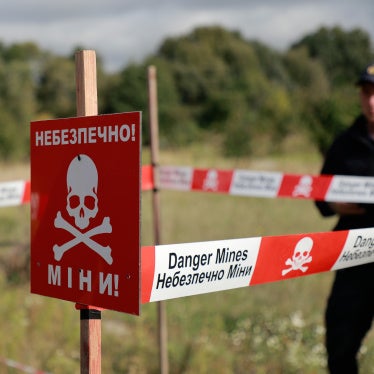Last week Russian state media gave big play to allegations that Ukrainian forces had used white phosphorus as an incendiary weapon in eastern Ukraine. In the midst of it, Russian Foreign Minister Sergei Lavrov urged an investigation into the use of incendiary weapons.
It all started on June 11 when the privately owned, pro-Kremlin Russian news outlet LifeNews posted a segment citing anti-Kiev insurgent claims of a white phosphorous attack on Semyonovka, a village near Slovyansk, the insurgency’s stronghold. The footage showed a luminous substance raining through a night sky. The next day, apparently reporting on the same incident, several Russian state media outlets said incendiary weapons were used in Ukraine, showing very different video footage. Ukrainian media (correctly) claimed that this footage was from a 2004 US white phosphorous attack in Iraq. The Russia state media refuted this.
Are you confused enough yet? And why does it matter?
It matters because white phosphorus, which can be used legitimately to generate smoke to temporarily mask the movement of troops or vehicles, should never be used as an incendiary weapon. It can inflict severe injuries, including chemical burns that go down to the bone. White phosphorus munitions aren’t banned, but because they spread a burning substance over a large area, they are particularly dangerous to civilians. Their use in populated areas violates the laws of war prohibition against attacks that cannot discriminate between civilians and combatants.
After analyzing the LifeNews video clip, Human Rights Watch arms researchers concluded that it didn’t show a white phosphorous – or an incendiary weapon – attack. What the video actually appears to show is an illuminant or a pyrotechnic. First, the intensity of the burning and the amount of smoke it generated aren’t consistent with white phosphorus. Second, the substance falling from the sky in the video has a haphazard pattern, unlike an incendiary weapon. Third, there is no flash of an explosive bursting charge, no instantaneous uniform ignition of the substance, both characteristic of white phosphorus munitions. Whatever is falling from the sky is breaking apart in a non-uniform manner, more akin to crumbling or disintegrating – incendiary weapons don’t do this.
The accusations around the claims are still flying. Ukrainian media outlets have published an apology written by two journalists for Zvezda, the Russian Ministry of Defense media outlet, who said they falsely reported on the use of white phosphorous (among other things) in Semyonovka. However, the circumstances under which the letter was written are still unclear. Both journalists had been detained by Ukrainian security services, and Ukrainian Channel 5 aired a video of one of the two journalists stating that his editors at Zvezda said he had to do the story. Again, this powerful claim is clouded by the fact that it was made while the journalist was in Ukrainian custody. The reporter’s black eye itself is a serious cause of concern.
This certainly wouldn’t be the first time that Russian state media has manufactured montages about eastern Ukraine, twisted the truth, or outright misstated facts. It’s difficult to avoid the impression that aside from mobilizing public outrage in Russia about Ukraine, these manipulations aim to distract and exhaust the experts whose job it is to sift between fact and fiction. It’s like an incendiary weapon that explodes, leaving in its wake anger and disorientation until the media cycle moves on. The Ukrainian media is also no stranger to this tactic.
Civilian casualties are rising in eastern Ukraine as the fighting between Ukrainian forces and insurgents intensifies. Documenting violations of international law by both sides is an important step toward preventing needless casualties. But that work is much harder when experts spend valuable time dispelling myths.










